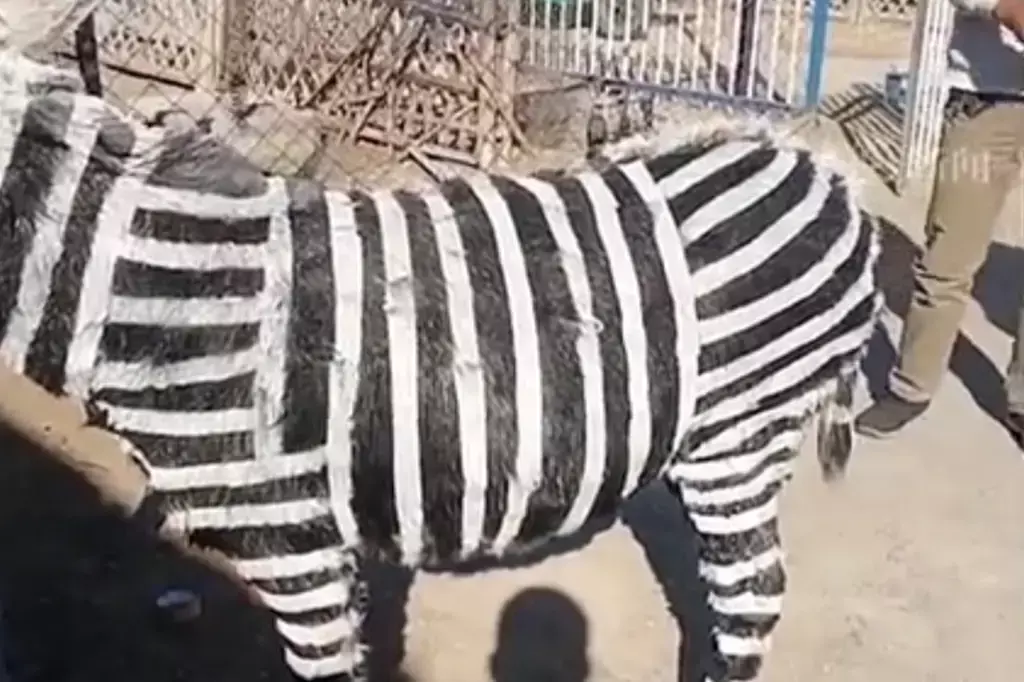
Chinese Zoo Admits to Painting Donkeys to Look Like Zebras
In a shocking revelation, a Chinese zoo in Shandong province has admitted to painting donkeys with black-and-white stripes to resemble zebras, sparking widespread outrage online. The zoo’s bizarre decision has sparked a heated debate about animal welfare and the ethics of zoos deceiving visitors.
According to reports, the zoo in Shandong’s Zaozhuang city painted the donkeys with non-toxic dye “for fun” as a way to attract more visitors. However, the move has been met with fierce criticism from animal lovers and experts, who argue that the practice is not only unethical but also potentially harmful to the animals.
The controversy began when photos of the painted donkeys were shared on social media, with many users expressing shock and disgust at the zoo’s actions. The zoo’s decision to disguise the donkeys as zebras has been seen as a desperate attempt to attract visitors, who may be disappointed to find that the animals are not the real deal.
Critics have pointed out that this is not the first time a Chinese zoo has resorted to such practices. In the past, zoos have been accused of dressing up animals in costumes or using prosthetics to deceive visitors. While the zoo’s claim that the dye is non-toxic may be true, experts argue that the psychological impact of being painted and displayed as a different species could be significant.
“Painting an animal to look like another species is not only deceptive but also potentially harmful,” said Dr. Emily Chen, an animal behaviorist at the University of California, San Diego. “Animals have a natural instinct to adapt to their environment, and when they are presented with a situation that is not natural, it can cause them stress and anxiety.”
The incident has also raised questions about the welfare of the donkeys themselves. While the zoo claims that the dye is non-toxic, many experts argue that painting an animal is still a form of manipulation and could be seen as a form of animal cruelty.
“The welfare of the animals should always be the top priority, and this practice is clearly not in the best interest of the donkeys,” said Jennifer Hill, an animal welfare advocate at the Humane Society of the United States. “Zoos have a responsibility to provide a safe and natural environment for the animals in their care, and this practice falls far short of that standard.”
The controversy has also sparked calls for stricter animal welfare laws in China. The country has made significant strides in recent years to improve animal welfare, but critics argue that more needs to be done to protect animals from exploitation and abuse.
“The Chinese government has made a commitment to improving animal welfare, but this incident shows that more needs to be done,” said Dr. Chen. “We need stricter laws and enforcement to ensure that animals are treated with the respect and dignity they deserve.”
In response to the backlash, the zoo has announced that it will stop painting the donkeys and will instead focus on providing a more natural environment for the animals. The zoo has also apologized for any distress caused to the public and has promised to work with animal welfare organizations to improve its practices.
While the zoo’s decision to stop painting the donkeys is a step in the right direction, the incident highlights the need for greater transparency and accountability in the zoo industry. Zoos have a responsibility to provide a safe and natural environment for the animals in their care, and they must be held accountable for any actions that may cause harm or distress to the animals.
As the debate continues, one thing is clear: the welfare of animals must always be the top priority. It is up to zoos, governments, and animal welfare organizations to work together to ensure that animals are treated with the respect and dignity they deserve.
Source: https://breezyscroll.com/world/china/chinese-zoo-admits-to-painting-donkeys-to-look-like-zebras/






